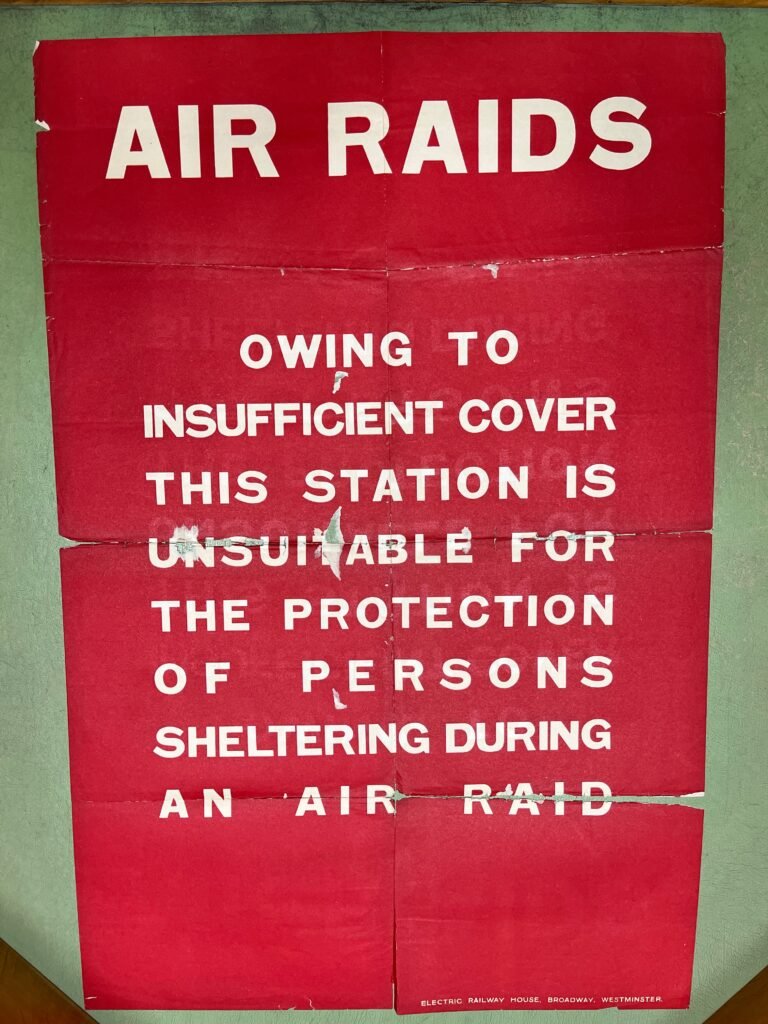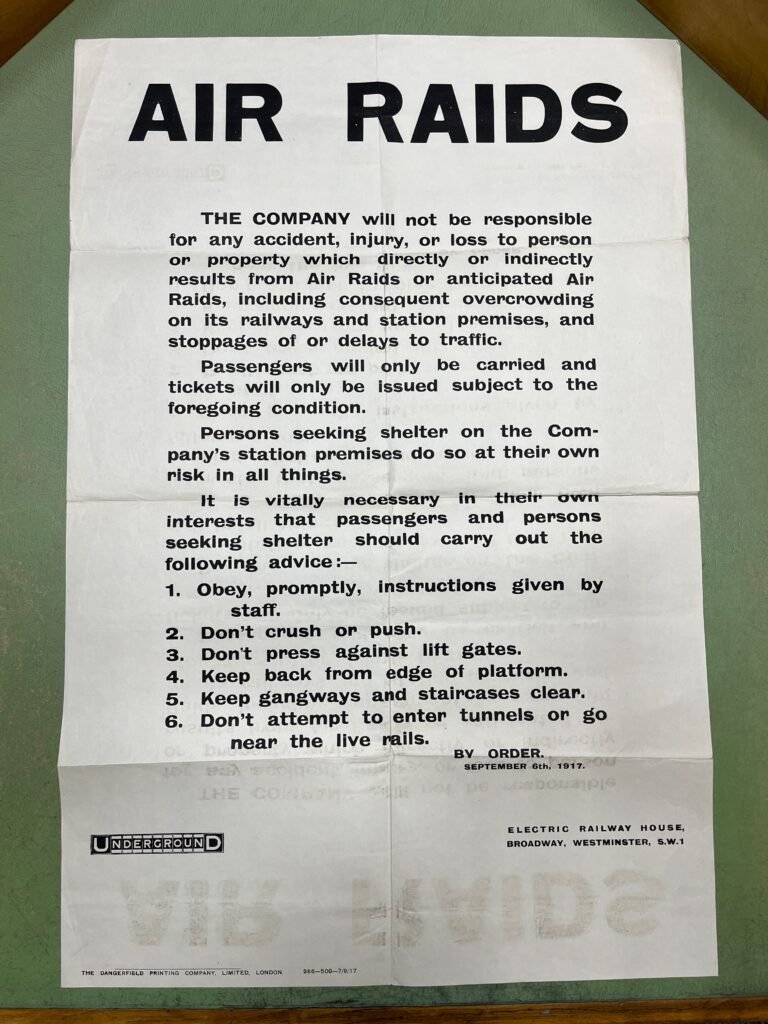
So, I’m back from my long-overdue and much-needed research trip to the UK. Was it worth it? Yes!
In raw numbers, I took over 11,000 photos across 13 days at 8 archives in 5 cities.1 Obviously, since I’m not a Bomber Command AOC I’m not going to prioritise quantity over quality. But I did pretty much, er, hit all my high priority targets and look at everything I really wanted to see. I struck archival gold nearly every day; there were only one or two places where the findings were meagre, and those visits were always a bit speculative anyway. I would like to have to visited the Tfl Corporate Archives (though check out the Underground posters I did find, above and below, from 1917-18 and 1917 respectively), or one or two other Home Counties archives. But you can’t see everything; and what I did see will make Home Fires Burning a much better book.
More specifically, I now have much deeper sources for civil defence, especially regarding shelters and, to a lesser extent, warnings, refugees, and patrols. A lot of my previous research necessarily had to rely on press accounts, but now I can say a lot more about what civil defence measures governments (central and local) took, particularly during the war, but also in planning in the 1920s for the next war. I also have some interesting sources on risk and compensation, and spectacle and shock, from personal archives as well as official ones. Finally, I’ve filled in long-standing gaps in my knowledge of both the Independent Force and its still-born successor, the Inter-Allied Independent Air Force, which, along with some good stuff on reprisals and a bit on French and German raid experiences mean I should be able to say something about the first bombing war.
In chronological terms, the relevant material I gathered during my last research trip in 2014 mainly covered up to 1916, which, since the Gotha raids of 1917-18 have assumed ever greater importance to the book project, has been a problem. I also didn’t have a lot of postwar sources. So in this trip I focused on sources from the last two years of the war, by a factor of nearly two to one (judging by my rough tagging), with another good chunk of postwar sources. Not only does this mean that I have enough sources to write this part of Home Fires Burning to the standard I want, but also that I will be able to, and probably should, split up my planned 1917-18 chapter into two. (With a corresponding compression of the prewar and 1914 chapters.)

Obviously I can’t get into a lot of detail about what I found in the archives – not least because I’m still assimilating it all! – but just as a teaser, I’ll close with a rather heated letter I found in the London Metropolitan Archives. It was sent on 31 July 1917 by Charles A. Cooper, managing director of Ajax (also known as the British Electric Institute), a purveyor of electrical ‘health’ apparatus on Holborn Viaduct, to the Corporation of London’s Public Health Department. The context is a request made in the wake of the 7 July daylight Gotha raid for permission to use a vault beneath their building as an air raid shelter:
We are exceedingly surprised at the slackness – not to say downright callousness – displayed by your Committee.
So long ago as July 17th, our British Secretary interviewed the [Public Health Department] Chairman and the Engineer, and at their invitation viewed the vaults beneath this building. Nothing could exceed their courtesy, and they said that if we made written application for permission to use the vault as a refuge for our female staff during a raid, it should be dealt with without fail in the morning. We wrote you at once accordingly, and received a formal acknowledgment, next day, that the matter should receive attention in due course. The ‘due course’ has not arrived, apparently!
If ever a matter was urgent, this is one. Raids may occur any day involving loss of lives, and should our female staff be sacrificed owing to lack of secure accomodation [sic], the Committee will bear the moral responsibility for their murder – and we shall take care that the public know it.
No trouble to the Committee is involved in dealing with our simple request: they are not expected to erect shelter: they are offered every security against its misuse: we are, as we have stated, ready to meet every reasonable demand, and it is simply careless callousness that is withholding this refuge from our staff.
These ladies might have been mutilated a dozen times, or murdered outright, during the past fortnight through the inaction of the Committee. Are the Committee waiting for some awful demonstration of ‘Kultur’ to occur before moving in this matter? Have they daughters of their own, exposed to mutilation and death through official indifference?
Let the committee read our letter of the 17th inst., making any amendments they like to the suggestions therein, so long as the main issue – that [of security] for ladies in times of danger – be not imperilled.2
The matter was resolved by the next day!
Image source: The National Archives, MEPO 2/1735.
![]() This work is licensed under a Creative Commons Attribution-NonCommercial-NoDerivatives 4.0 International License.
Permissions beyond the scope of this license may be available at http://airminded.org/copyright/.
This work is licensed under a Creative Commons Attribution-NonCommercial-NoDerivatives 4.0 International License.
Permissions beyond the scope of this license may be available at http://airminded.org/copyright/.
- About five-sixths of these were taken at the National Archives alone. [↩]
- London Metropolitan Archives, COL/CC/STS/02/01/003, 1917/13A. [↩]






Speaking as a retired public archivist (30-plus years with the U.S. National Archives and Records Administration), the biggest transformation in research methodology was the arrival of the cell phone and portable scanners.
We had cases of people (thankfully few) who would soil themselves rather than walk away from the copying machine that they were sweating over to max out their allotted time!
I am happy to say I was never quite that committed to my research! But I can certainly understand the motivation…